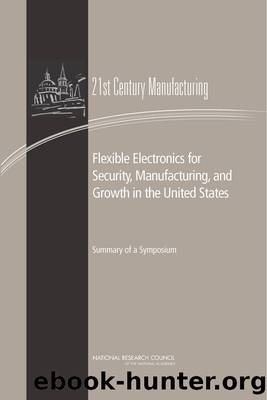Flexible Electronics for Security, Manufacturing, and Growth in the United States by Sujai J. Shivakumar

Author:Sujai J. Shivakumar
Language: eng
Format: epub
Tags: ebook
Publisher: The National Academies Press
Published: 2013-12-07T00:00:00+00:00
ONE STATEâS INITIATIVE:
ADVANCING FLEXIBLE ELECTRONICS IN OHIO
Byron Clayton
NorTech
Dr. Clayton said that the state of Ohio had introduced its own flexible electronics initiative, called NorTech, and that he had noticed four trends. The first reflected the remarks of many other speakers about the need for government investment. In Ohio, he said, his organization viewed investment in flexible electronics as a larger enterprise involving the state, federal government, and private firms. âWe think itâs part of the stateâs job to help spur that private investment.â Second, he said that the trend of cultivating collaboration across sectors, also mentioned by other speakers, was an emphasis in Ohio. A third trend was the broad effort to help firms scale up their roll-to-roll manufacturing capability. The fourth trend, not yet begun, would reflect the need for northeastern Ohio and for the state as a whole to stimulate market pull.
He said that NorTech was a technology-based economic development organization, based in Cleveland, which covered 21 counties. Its specific role is to focus on emerging technology industries, with a current emphasis on advanced energy and flexible electronics. He said that the strategy of NorTech was not simply to raise money from the state, but to use that money to leverage federal and private funding as well. As examples of this, he said that the region had recently been awarded an i6 Challenge,6 as well as a Small Business Administration (SBA) award specifically to help grow the existing flexible electronics cluster.
Building Relationships Across Sectors
At NorTech, he said, the first objective was to build relationships across sectors, for example, with funders who work with universities, small medium and large businesses, and the federal and state governments. Another objective was to draw the activities of industry together in the form of roadmaps. He had just completed one for the flexible electronics industry, in partnership with Dr. Gamota, another speaker at the symposium. âThe roadmap weâve developed is a strategic roadmap,â he said. âWe know there are technology roadmaps already developed, so we focused on what do we need to do to grow the industry. This includes collaboration, investment, scaling up manufacturing, and focusing on market pull.â
Dr. Clayton discussed a model that he said had worked for NorTech. Technology commercialization was imagined as a continuum of five stages: imagining, integrating, demonstrating, market entry, and growth. The program is structured to allow the infusion of money at the most appropriate point of this technology commercialization continuum.
To do so, he said, the model had been subdivided into several program levels. The largest was the Ohio Third Frontier Investment, a $2.3 billion program designed to focus on the first three phases: doing the basic research, incubating the new firm, and developing the products to the proof-of-concept stage. The Third Frontier program had begun as a $1.6 billion program in 2002. It was placed before the voters in a referendum that failed to pass. NorTech succeeded in placing it as a bipartisan bond issue a second time, when it passed with about 52 percent of voters in favor of it.
Download
This site does not store any files on its server. We only index and link to content provided by other sites. Please contact the content providers to delete copyright contents if any and email us, we'll remove relevant links or contents immediately.
Whiskies Galore by Ian Buxton(41718)
Introduction to Aircraft Design (Cambridge Aerospace Series) by John P. Fielding(33016)
Small Unmanned Fixed-wing Aircraft Design by Andrew J. Keane Andras Sobester James P. Scanlan & András Sóbester & James P. Scanlan(32684)
Aircraft Design of WWII: A Sketchbook by Lockheed Aircraft Corporation(32162)
Craft Beer for the Homebrewer by Michael Agnew(18081)
Turbulence by E. J. Noyes(7893)
The Complete Stick Figure Physics Tutorials by Allen Sarah(7264)
The Institute by Stephen King(6857)
Kaplan MCAT General Chemistry Review by Kaplan(6822)
The Thirst by Nesbo Jo(6758)
Bad Blood by John Carreyrou(6476)
Modelling of Convective Heat and Mass Transfer in Rotating Flows by Igor V. Shevchuk(6353)
Learning SQL by Alan Beaulieu(6158)
Weapons of Math Destruction by Cathy O'Neil(6084)
Man-made Catastrophes and Risk Information Concealment by Dmitry Chernov & Didier Sornette(5877)
Permanent Record by Edward Snowden(5681)
Digital Minimalism by Cal Newport;(5586)
Life 3.0: Being Human in the Age of Artificial Intelligence by Tegmark Max(5403)
iGen by Jean M. Twenge(5321)
